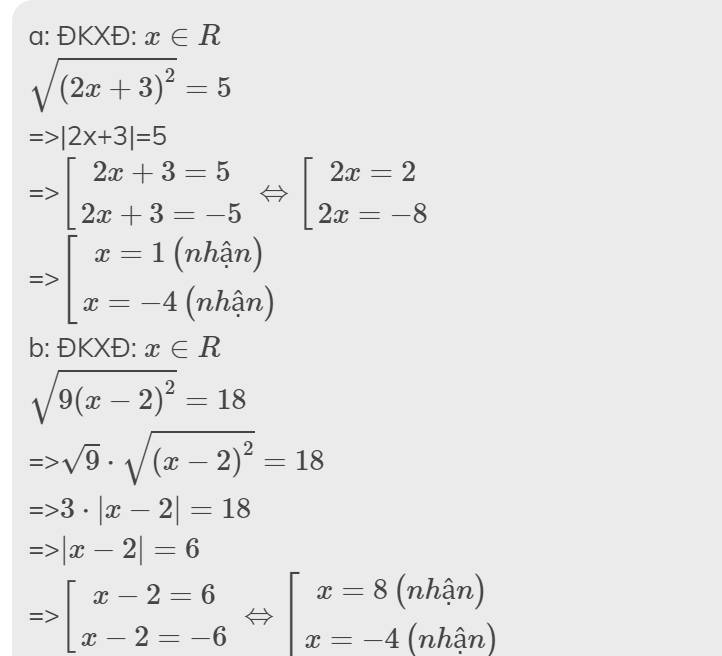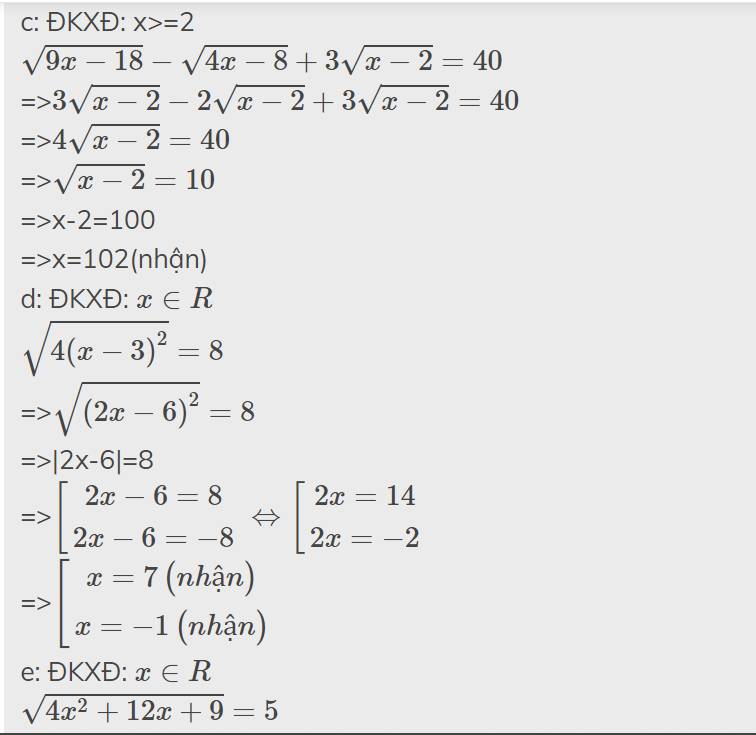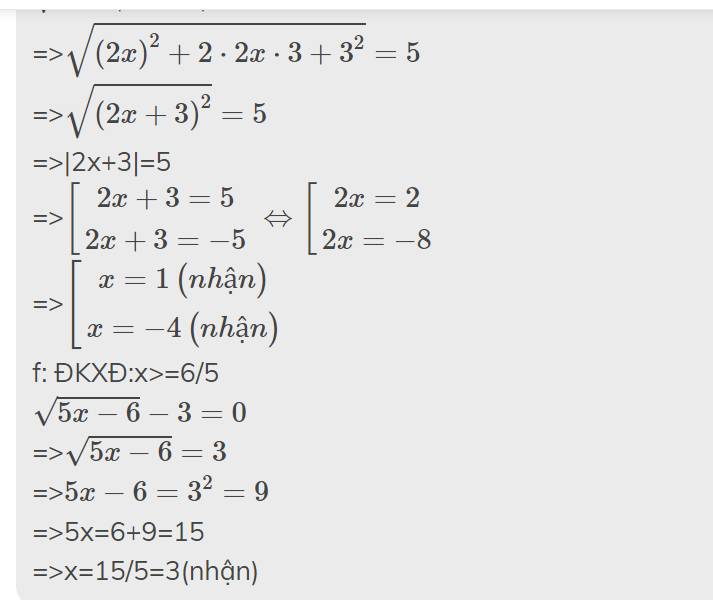Hãy nhập câu hỏi của bạn vào đây, nếu là tài khoản VIP, bạn sẽ được ưu tiên trả lời.

1.
\(\Leftrightarrow\left(2x+1\right)\sqrt{2x^2+4x+5}-\left(2x+1\right)\left(x+3\right)+x^2-2x-4=0\)
\(\Leftrightarrow\left(2x+1\right)\left(\sqrt{2x^2+4x+5}-\left(x+3\right)\right)+x^2-2x-4=0\)
\(\Leftrightarrow\dfrac{\left(2x+1\right)\left(x^2-2x-4\right)}{\sqrt{2x^2+4x+5}+x+3}+x^2-2x-4=0\)
\(\Leftrightarrow\left[{}\begin{matrix}x^2-2x-4=0\\\dfrac{2x+1}{\sqrt{2x^2+4x+5}+x+3}+1=0\left(1\right)\end{matrix}\right.\)
\(\left(1\right)\Leftrightarrow2x+1+\sqrt{2x^2+4x+5}+x+3=0\)
\(\Leftrightarrow\sqrt{2x^2+4x+5}=-3x-4\) \(\left(x\le-\dfrac{4}{3}\right)\)
\(\Leftrightarrow2x^2+4x+5=9x^2+24x+16\)
\(\Leftrightarrow7x^2+20x+11=0\)
2.
ĐKXĐ: ...
\(\Leftrightarrow2x\sqrt{2x+7}+7\sqrt{2x+7}=x^2+2x+7+7x\)
\(\Leftrightarrow\left(x^2-2x\sqrt{2x+7}+2x+7\right)+7\left(x-\sqrt{2x+7}\right)=0\)
\(\Leftrightarrow\left(x-\sqrt{2x+7}\right)^2+7\left(x-\sqrt{2x+7}\right)=0\)
\(\Leftrightarrow\left(x-\sqrt{2x+7}\right)\left(x+7-\sqrt{2x+7}\right)=0\)
\(\Leftrightarrow\left[{}\begin{matrix}x=\sqrt{2x+7}\\x+7=\sqrt{2x+7}\end{matrix}\right.\)
\(\Leftrightarrow...\)

a) Ta có: \(\sqrt{25x+75}+3\sqrt{x-2}=2\sqrt{x-2}+\sqrt{9x-18}\)
\(\Leftrightarrow5\sqrt{x+3}+3\sqrt{x-2}=2\sqrt{x-2}+3\sqrt{x-2}\)
\(\Leftrightarrow\sqrt{25x+75}=\sqrt{4x-8}\)
\(\Leftrightarrow25x-4x=-8-75\)
\(\Leftrightarrow21x=-83\)
hay \(x=-\dfrac{83}{21}\)
b) Ta có: \(\sqrt{\left(2x-1\right)^2}=4\)
\(\Leftrightarrow\left|2x-1\right|=4\)
\(\Leftrightarrow\left[{}\begin{matrix}2x-1=4\\2x-1=-4\end{matrix}\right.\Leftrightarrow\left[{}\begin{matrix}2x=5\\2x=-3\end{matrix}\right.\Leftrightarrow\left[{}\begin{matrix}x=\dfrac{5}{2}\\x=-\dfrac{3}{2}\end{matrix}\right.\)
c) Ta có: \(\sqrt{\left(2x+1\right)^2}=3x-5\)
\(\Leftrightarrow\left|2x+1\right|=3x-5\)
\(\Leftrightarrow\left[{}\begin{matrix}2x+1=3x-5\left(x\ge-\dfrac{1}{2}\right)\\2x+1=5-3x\left(x< \dfrac{1}{2}\right)\end{matrix}\right.\)
\(\Leftrightarrow\left[{}\begin{matrix}2x-3x=-5-1\\2x+3x=5-1\end{matrix}\right.\Leftrightarrow\left[{}\begin{matrix}x=6\left(nhận\right)\\x=\dfrac{4}{5}\left(loại\right)\end{matrix}\right.\)
d) Ta có: \(\sqrt{4x-12}-14\sqrt{\dfrac{x-2}{49}}=\sqrt{9x-18}+8\)
\(\Leftrightarrow2\sqrt{x-3}-2\sqrt{x-2}=3\sqrt{x-2}+8\)
\(\Leftrightarrow2\sqrt{x-3}-5\sqrt{x-2}=8\)
\(\Leftrightarrow4\left(x-3\right)+25\left(x-2\right)-20\sqrt{x^2-5x+6}=8\)
\(\Leftrightarrow4x-12+25x-50-8=20\sqrt{\left(x-2\right)\left(x-3\right)}\)
\(\Leftrightarrow20\sqrt{\left(x-2\right)\left(x-3\right)}=29x-70\)
\(\Leftrightarrow x^2-5x+6=\dfrac{\left(29x-70\right)^2}{400}\)
\(\Leftrightarrow x^2-5x+6=\dfrac{841}{400}x^2-\dfrac{203}{20}x+\dfrac{49}{4}\)
\(\Leftrightarrow\dfrac{-441}{400}x^2+\dfrac{103}{20}x-\dfrac{25}{4}=0\)
\(\Delta=\left(\dfrac{103}{20}\right)^2-4\cdot\dfrac{-441}{400}\cdot\dfrac{-25}{4}=-\dfrac{26}{25}\)(Vô lý)
vậy: Phương trình vô nghiệm

Đk: \(x\ge2\)
pt <=> \(\frac{4\left(x+2\right)-\left(4x+1\right)}{2\sqrt{x+2}+\sqrt{4x+1}}\left(2x+3+\sqrt{4x^2+9x+2}\right)=7\)
<=> \(\frac{7}{2\sqrt{x+2}+\sqrt{4x+1}}\left(2x+3+\sqrt{4x^2+9x+2}\right)=7\)
<=> \(2x+3+\sqrt{4x^2+9x+2}=2\sqrt{x+2}+\sqrt{4x+1}\)(1)
Đặt : \(t=2\sqrt{x+2}+\sqrt{4x+1}\ge0\)
Ta có: \(t^2=8x+9+4\sqrt{4x^2+9x+2}\)<=> \(2x+3+\sqrt{4x^2+9x+2}=\frac{t^2+3}{4}\)
Phương trình (1) trở thành: \(\frac{t^2+3}{4}=t\Leftrightarrow t^2-4t+3=0\Leftrightarrow\orbr{\begin{cases}t=3\\t=1\end{cases}\left(tm\right)}\)
+) Với t = 1. Ta có:
\(2\sqrt{x+2}+\sqrt{4x+1}=1\)
<=> \(8x+9+4\sqrt{4x^2+9x+2}=1\)
<=> \(\sqrt{4x^2+9x+2}=-2-2x\)
<=> \(\hept{\begin{cases}-2-2x\ge0\\4x^2+9x+2=4x^2+8x+4\end{cases}\Leftrightarrow}\hept{\begin{cases}x\le-1\\x=2\end{cases}}\)loại
+) Với t = 3. Ta có:
\(2\sqrt{x+2}+\sqrt{4x+1}=3\)
<=> \(8x+9+4\sqrt{4x^2+9x+2}=9\)
<=> \(\sqrt{4x^2+9x+2}=-2x\)
<=> \(\hept{\begin{cases}-2x\ge0\\4x^2+9x+2=4x^2\end{cases}\Leftrightarrow}\hept{\begin{cases}x\le0\\9x+2=0\end{cases}}\Leftrightarrow x=-\frac{2}{9}\left(tmdk\right)\)
Vây:...
ĐK \(x\ge\frac{-1}{4}\)
Với điều kiện đó ta có \(2\sqrt{x+2}+\sqrt{4x+1}>0\)
Biến đổi phương trình đã cho trở thành
\(7\left(2x+3+\sqrt{4x^2+9x+2}\right)7\left(2\sqrt{x+2}+\sqrt{4x+1}\right)\)
\(\Leftrightarrow2x+3+\sqrt{4x^2+9x+2}=2\sqrt{x+2}+\sqrt{4x+1}\left(1\right)\)
Đặt \(t=2\sqrt{x+2}+\sqrt{4x+1}\left(t\ge\sqrt{7}\right)\)
\(t^2=8x+9+4\sqrt{4x^2+9x+2}\Rightarrow2x+\sqrt{4x^2+9x+2}=\frac{t^2-9}{4}\)
Thay vào (1) ta được \(t^2-4t+3=0\Leftrightarrow\orbr{\begin{cases}t=1\left(ktm\right)\\t=3\left(tm\right)\end{cases}}\)
Với t=3 ta có:\(2\sqrt{x+2}+\sqrt{4x+1}=3\)giải ra ta được \(x=\frac{-2}{9}\left(tm\right)\)
Vậy pt có 1 nghiệm duy nhất \(x=-\frac{2}{9}\)

Đặt \(2x+1=a,3x=b\)
=> \(a^2=4x^2+4x+1,b^2=9x^2\)
Khi đó
PT <=> \(a\left(2+\sqrt{a^2+3}\right)+b\left(2+\sqrt{b^2+3}\right)=0\)
<=> \(2\left(a+b\right)+\left(a\sqrt{a^2+3}+b\sqrt{b^2+3}\right)=0\)
<=> \(2\left(a+b\right)+\frac{a^2\left(a^2+3\right)-b^2\left(b^2+3\right)}{a\sqrt{a^2+3}-b\sqrt{b^2+3}}=0\)
<=> \(2\left(a+b\right)+\frac{\left(a+b\right)\left(a-b\right)\left(a^2+b^2+3\right)}{a\sqrt{a^2+3}-b\sqrt{b^2+3}}=0\)
\(\orbr{\begin{cases}a+b=0\\2+\frac{\left(a-b\right)\left(a^2+b^2+3\right)}{a\sqrt{a^2+3}-b\sqrt{b^2+3}}=0\left(2\right)\end{cases}}\)
Phương trình (2) vô nghiêm vì \(\frac{a-b}{a\sqrt{a^2+3}-b\sqrt{b^2+3}}\ge0\)do a>b thì tử >0, mẫu >0 và ngược lại a<b
=> \(2x+1+3x=0\)
=> \(x=-\frac{1}{5}\)
Vậy \(x=-\frac{1}{5}\)

Lời giải:
a.
PT $\Leftrightarrow |2x+1|=|x-1|$
$\Leftrightarrow 2x+1=x-1$ hoặc $2x+1=-(x-1)$
$\Leftrightarrow x+2=0$ hoặc $3x=0$
$\Leftrightarrow x=-2$ hoặc $x=0$ (tm)
b.
PT $\Leftrightarrow 9x^2-6x+1=x^2-4x+4$
$\Leftrightarrow 8x^2-2x-3=0$
$\Leftrightarrow (4x-3)(2x+1)=0$
$\Leftrightarrow 4x-3=0$ hoặc $2x+1=0$
$\Leftrightarrow x=\frac{3}{4}$ hoặc $x=\frac{-1}{2}$ (tm)
a: =>|2x+1|=|x-1|
=>2x+1=x-1 hoặc 2x+1=-x+1
=>x=-2 hoặc x=0
b: =>|3x-1|=|x-2|
=>3x-1=x-2 hoặc 3x-1=-x+2
=>2x=-1 hoặc 4x=3
=>x=-1/2 hoặc x=3/4

Câu 4:
Giả sử điều cần chứng minh là đúng
\(\Rightarrow x=y\), thay vào điều kiện ở đề bài, ta được:
\(\sqrt{x+2014}+\sqrt{2015-x}-\sqrt{2014-x}=\sqrt{x+2014}+\sqrt{2015-x}-\sqrt{2014-x}\) (luôn đúng)
Vậy điều cần chứng minh là đúng
2) \(\sqrt{x^2-5x+4}+2\sqrt{x+5}=2\sqrt{x-4}+\sqrt{x^2+4x-5}\)
⇔ \(\sqrt{\left(x-4\right)\left(x-1\right)}-2\sqrt{x-4}+2\sqrt{x+5}-\sqrt{\left(x+5\right)\left(x-1\right)}=0\)
⇔ \(\sqrt{x-4}.\left(\sqrt{x-1}-2\right)-\sqrt{x+5}\left(\sqrt{x-1}-2\right)=0\)
⇔ \(\left(\sqrt{x-4}-\sqrt{x+5}\right)\left(\sqrt{x-1}-2\right)=0\)
⇔ \(\left[{}\begin{matrix}\sqrt{x-4}-\sqrt{x+5}=0\\\sqrt{x-1}-2=0\end{matrix}\right.\)
⇔ \(\left[{}\begin{matrix}\sqrt{x-4}=\sqrt{x+5}\\\sqrt{x-1}=2\end{matrix}\right.\)
⇔ \(\left[{}\begin{matrix}x\in\varnothing\\x=5\end{matrix}\right.\)
⇔ x = 5
Vậy S = {5}

a)Đk:\(x\ge\frac{1}{2}\)
\(pt\Leftrightarrow4x^2-12x+4+4\sqrt{2x-1}=0\)
\(\Leftrightarrow\left(2x-1\right)^2-4\left(2x-1\right)-1+4\sqrt{2x-1}=0\)
Đặt \(t=\sqrt{2x-1}>0\Rightarrow\hept{\begin{cases}t^2=2x-1\\t^4=\left(2x-1\right)^2\end{cases}}\)
\(t^4-4t^2+4t-1=0\)
\(\Leftrightarrow\left(t-1\right)^2\left(t^2+2t-1\right)=0\)
\(\Rightarrow\orbr{\begin{cases}t-1=0\\t^2+2t-1=0\end{cases}}\)\(\Rightarrow\orbr{\begin{cases}t=1\\t=\sqrt{2}-1\end{cases}\left(t>0\right)}\)
\(\Rightarrow\orbr{\begin{cases}x=1\\x=2-\sqrt{2}\end{cases}}\) là nghiệm thỏa pt



\(pt\Leftrightarrow3x\left(2+\sqrt{\left(3x\right)^2+3}\right)=-\left(2x+1\right)\)\(\left(2+\sqrt{\left(2x+1\right)^2+3}\right)\)
Nếu 3x = - (2x + 1)\(\Leftrightarrow x=-\frac{1}{5}\)thì các biểu thức trong căn của hai vế bằng nhau.Vậy \(x=-\frac{1}{5}\)là 1 nghiệm của phương trình.
Hơn nữa, nghiệm của pt nằm trong khoảng \(\left(\frac{-1}{2};0\right)\).Ta chứng minh đó là nghiệm duy nhất.
Với \(-\frac{1}{2}< x< -\frac{1}{5}:3x< -2x-1< 0\)
\(\Rightarrow\left(3x\right)^2>\left(2x+1\right)^2\)\(\Rightarrow2+\sqrt{\left(3x\right)^2+3}>2+\sqrt{\left(2x+1\right)^2+3}\)
Suy ra \(3x\left(2+\sqrt{\left(3x\right)^2+3}\right)+\left(2x+1\right)\)\(\left(2+\sqrt{\left(2x+1\right)^2+3}\right)>0\)pt không có nghiệm nằm trong khoảng này.CMTT: ta cũng đi đến kết luận pt không có nghiệm khi \(-\frac{1}{2}< x< -\frac{1}{5}\)
Vậy nghiệm duy nhất của phương trình là \(\frac{-1}{5}\)
PT tương đương
\(\left(2x+1\right)\left(2+\sqrt{\left(2x+1\right)^2+3}\right)=-3x\left(2+\sqrt{\left(-3x\right)^2+3}\right)\)
\(\Leftrightarrow f\left(2x+1\right)=f\left(-3x\right)\)
Trong đó \(f\left(t\right)=t\left(2+\sqrt{t^2+3}\right)\)là hàm đồng biến và liên tục trong R. Phương trình trở thành
\(f\left(2x+1\right)=f\left(-3x\right)\Leftrightarrow2x+1=-3x\Leftrightarrow x=\frac{-1}{5}\)là nghiệm duy nhất